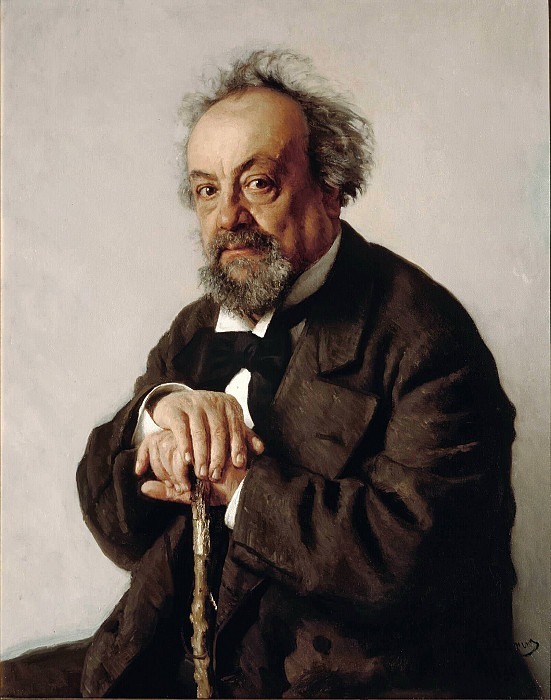Portrait of the writer A.F. Pisemsky Ilya Repin (1844-1930)
Ilya Repin – Portrait of the writer A.F. Pisemsky
Edit attribution
Download full size: 1610×2048 px (0,3 Mb)
Painter: Ilya Repin
Location: The State Tretyakov Gallery, Moscow (Государственная Третьяковская галерея).
It is known that Repin turned to the genre of portraiture an incredible number of times during his career. And most interestingly, each of them was invariably crowned with success. Poor or rich, old or young, each person looks in its own original and unique. Repin knew how to display in a portrait that individual trait, which would distinguish the painting from a number of others. And that feature was not always appearance. This canvas was created in 1880 and for many years now is in the State Tretyakov Gallery.
Description of Ilya Repin’s Portrait of Pisemsky
It is known that Repin turned to the genre of portraiture an incredible number of times during his career. And most interestingly, each of them was invariably crowned with success. Poor or rich, old or young, each person looks in its own original and unique. Repin knew how to display in a portrait that individual trait, which would distinguish the painting from a number of others. And that feature was not always appearance.
This canvas was created in 1880 and for many years now is in the State Tretyakov Gallery. Dimensions of the picture reaches just over 60 cm in width by 90 centimeters in height. In many of his canvases the artist depicts a man at the waist, so that the face, shoulders and chest looked the most expressive. The same principle followed Repin and in this case, but that’s just the body is hidden under a large jacket of gray. The writer, which painted Repin, sitting on a chair and leaning his hands on a cane. Many art historians say that the image can not be called an ordinary portrait, as it is accustomed to consider.
Repin very accurately convey the character of his client. He drew every feature, every wrinkle so technically, that many of Pisemsky’s friends were struck by the mystical resemblance to the original. There is a feeling that Pisemsky looks at us not from a meter-long canvas, but from an ordinary enlarged photograph. Except that the cameras did not yet have their future glory. The painting breathes with life and Pismsky is about to rise from his chair and begin to stroll around the room. This liveliness is in some way conveyed by the unusual facial expression of the hero: raised eyebrow, surprised face, a slight, almost imperceptible smile at the corners of the lips.
Кому понравилось
Пожалуйста, подождите
На эту операцию может потребоваться несколько секунд.
Информация появится в новом окне,
если открытие новых окон не запрещено в настройках вашего браузера.
You need to login
Для работы с коллекциями – пожалуйста, войдите в аккаунт (open in new window).




















You cannot comment Why?
Pisemsky has a full, graying beard and mustache, and his hair is unkempt, adding to a somewhat disheveled yet intellectual appearance. His brow is furrowed, and his eyes, while looking directly at us, seem to hold a depth that suggests a life lived and many stories told. He is dressed in a dark suit with a white shirt and a dark bow tie, a formal attire that is slightly softened by his untidy hair. The walking stick, with its weathered appearance and ornate handle, could symbolize his seniority or perhaps a physical ailment, but also a certain robustness of character.
The background is a plain, light gray, which helps to isolate the subject and draw all attention to him. The lighting creates strong contrasts, highlighting the textures of his skin, hair, and clothing, and further emphasizing the contours of his face and hands.
The subtext of this portrait likely lies in the artists attempt to capture the essence of an esteemed writer. Pisemskys direct gaze and the gravity of his expression suggest wisdom, experience, and perhaps a touch of melancholy or contemplation common to intellectuals who have observed the human condition closely through their work. The portrait doesnt shy away from depicting the signs of aging, instead portraying them as marks of character and a life fully lived. The walking stick, rather than being just an accessory, can be seen as a symbol of his journey and his ongoing presence in the literary world. Overall, the painting evokes a sense of respect and contemplation for the subjects intellectual achievements and personal journey.